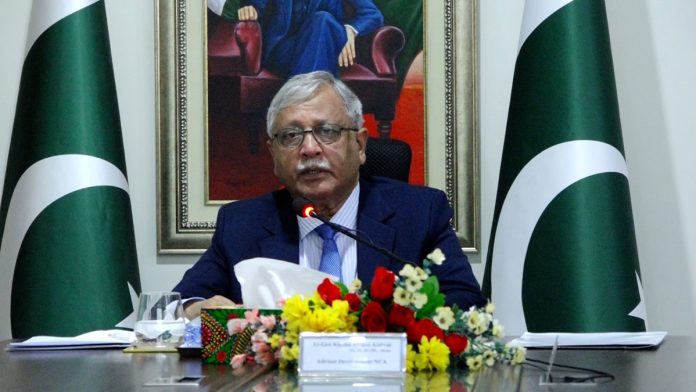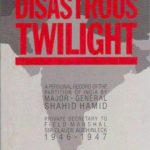On May 13, 2024, the Strategic Vision Institute (SVI), under the leadership of Brigadier Dr. Naeem Salik, hosted a webinar titled “NUCLEARIZATION OF SOUTH ASIA: CHALLENGES TO REGIONAL PEACE AND STABILITY.” This event saw active participation from several prominent institutions, including the Center for International Strategic Studies (CISS), the Center for International Strategic Studies Sindh (CISSS), the Balochistan Think Tank Network (BTTN), and Rabita Forum International (RFI).
Lt. General Khalid Ahmed Kidwai, NI, HI, HI (M), Advisor Development National Command Authority (AD NCA), delivered a profound keynote address on the theme “INDIAN NUCLEAR PROGRAM AND TESTS OF MAY 1998: CHALLENGES TO NATIONAL SECURITY OF PAKISTAN” in the webinar. His address offered deep insights into the critical issues surrounding the nuclearization of the region and its implications for Pakistan’s security. The full text of his keynote speech is published here for the benefit of our readers.
Dr. Naeem Salik, Executive Director Strategic Vision Institute, Air Commodore Khalid Banuri, our Moderator for today’s Webinar, ladies and gentlemen. Assalam Alaikum.
It gives me great pleasure to participate in today’s Webinar being conducted by SVI to commemorate the 27th Yom Takbir. My compliments to Dr. Naeem Salik and team SVI on taking a lead in holding a series of four Webinars on the occasion, this being the first one.
There can be no doubt that 28th May 1998, and two days later, 30th May 1998, are amongst the most important and critical dates in Pakistan’s history since 1947. These are two momentous days that placed Pakistan for an infinite time amongst the elite world powers, an exclusive club, which possesses a nuclear weapons capability; the 7th nation to be exact. The status is many, many, notches above the ordinary.
Pakistan has every reason to celebrate the day with national pride and happiness, tempered by national humility and gratitude to Allah Almighty for providing Pakistan with a deterrence capability that is considered as the ultimate guarantee of national security against external aggression. As is often stated in drawing room conversations, the acquisition of a nuclear weapons capability by Pakistan is indeed a miracle of Allah; we can never thank Him enough.
Before proceeding further, at the outset, I would like to pay my humble tribute to the great scientists and engineers of Pakistan’s strategic organizations for their selfless, dedicated, outstanding professional work, which has secured Pakistan against aggression, as I said, for an infinite time. And this against the greatest of odds and challenges in an environment of strictest of international sanctions and denials.
There was never a shortage of international threats and politico diplomatic coercion on Pakistan to freeze or roll back the nuclear programme especially during the infancy days of the programme, and at other times subsequently. In this context, tributes are also owed very much to Pakistan’s top political, military, and diplomatic leadership all through during those momentous decades, from the early 1970s to date, well over half a century, for providing a unified national consensus, determination, and showing spine internationally irrespective of the politics of the day, to stay the course for achieving Pakistan’s strategic security objectives.
It is this unified national consensus which has been the greatest source of strength for Pakistan’s nuclear programme. And I say this with conviction from my personal experience of 15 plus years at the SPD when all doors in the decision making corridors of the state would fling open with the strongest sense of patriotism and emotion to support Pakistan’s strategic programme in whichever way each individual could. It was his or her way of participating, contributing and doing their bit in the high cause of national security.
When we say that Pakistan’s nuclear deterrence capability is the cornerstone of Pakistan’s security and is central to Pakistan’s survival, you will probably agree with me that this simple common wisdom is deeply ingrained in the psyche of Pakistanis at the common man’s level. It will not be wrong to say that the Pakistani street owns Pakistan’s nuclear programme; it gets hugely perturbed when it smells the first sign of a potential threat. Follow the social media and you will understand what I mean when conspiracy theories have a field day. It is the Pakistani street that stands as a bulwark against such theories. A Ghauri or a Shaheen painted at the back of a goods truck on Pakistan’s highways says it all.
This particular Webinar focuses on three aspects, or questions, which I shall try to reflect upon.
The first aspect is as to why India pursued its nuclear weapons programme and conducted nuclear tests initially in 1974 and then in 1998. Well the history of India’s nuclear weapons programme is very well recorded in a large number of publications both internationally and within India. The subject is very well researched and there are any number of opinions on it. One of my favourites is the very objectively written book “India’s Nuclear Bomb: The Impact on Global Proliferation” by George Perkovich of the Carnegie Endowment in Washington.
There appears to be a broad unanimity amongst most scholars and academics that the Indian nuclear programme has been driven mostly by a fierce national desire, pride if you may, especially amongst the Indian elite rather than the common Indian, to be counted amongst important regional and global powers. A permanent seat at the UN Security Council is seen as the ultimate prize and for that, India has always considered that a nuclear weapons capability is a pre-requisite; it may well be true because all the P-5 countries at the UN Security Council are nuclear weapons powers.
There have also been opinions expressed that India’s nuclear weapons programme is driven by India’s national security concerns especially viz China. There may be a grain of truth in that too but in considering this rationale we may like to recall that India’s nuclear programme was put on course very early on after independence and for quite a few years thereafter, there was much bon-homie between India and China symbolized by the famous Hindi-Chini Bhai-Bhai slogans. Evidently, China was not seen as a national security threat at the time, the mid-1950s to be exact, and yet there was a blossoming Indian nuclear programme with a fairly clearly defined objective of a nuclear weapon as the ultimate goal. The real driver of the Indian nuclear programme may well be somewhere in between but one consistent reality of India’s foreign policy has always been to see India in the big league with a global status. I shall leave it at that.
As to why India conducted nuclear tests at Pokhran in 1974 and then again in 1998, the one straight forward reason on both occasions of course would be that India was technically and scientifically speaking quite ready to undertake the nuclear tests and the scientist community needed to conduct hot tests of the nuclear devices. While computer simulations, cold tests, counting the massive numbers of neutrons released, and the timing of the simultaneity of firing of the explosives for compression of the nuclear core, in a cold test, are all very well, it is only by conducting a real time hot test that a nuclear device can be certified to be a fully functional capability in all respects.
However, a much greater reason than technical considerations has to be the attainment of certain vital geo-political, national security and domestic political objectives. Much of the nuclear deterrence theory relies, first of all, on the possession of a credible nuclear capability, which then requires strong messaging for the generation of desired strategic effects viz the target strategic audience including adversaries. In 1974, while India militarily was flush with its success against Pakistan in the 1971 War, domestically Mrs. Indira Gandhi’s Government was having serious political problems. Mrs. Indira Gandhi wanted to display further muscle as an iron lady and benefit politically both nationally and internationally, confident in India’s strong relationship with the then USSR which would shield India from any adverse action in the UN Security Council. And so, she took the high risk gamble and I would say succeeded in getting away with it with barely a wrap on the knuckles. Naming the test as Smiling Budha and calling it a peaceful nuclear explosion was quite a naive and silly attempt at deception which no one in the world bought. A nuclear explosion is a nuclear explosion and there is nothing very peaceful about it.
While India got away with its 1974 nuclear test lightly, paradoxically Pakistan suffered far greater consequences for India’s sins by the imposition of sanctions on critical Pakistani entities. This was western hypocrisy and convoluted logic standing on its head. On the flip side however, the event shook the Pakistani triad of politico-military-scientific leadership and the triad renewed the national determination to go full steam ahead in the pursuit of a national nuclear weapons capability, first visualized politically in 1972.
There was no other way to restore the altered strategic balance to Pakistan’s severe disadvantage multiplied by the environment of a conventional force asymmetry in favour of India. The loss of East Pakistan in 1971 together now with Pokhran-I of 1974 therefore became the driver of the Pakistani journey in search of nuclear weapons – at the fastest speed possible. Pakistan had no choice but to live with the strategic imbalance in the intervening few years. It was the result of the earlier poor assessment of the strategic balance between India and Pakistan. The 1974 event also gave a further fillip to the competition between the Pakistan Atomic Energy Commission (PAEC) and the Dr A Q Khan Laboratory (KRL). The race was now on well and truly to deliver Pakistan a nuclear weapon. To their everlasting credit, the Pakistani strategic scientist community rose to the occasion and though somewhat unhealthy at times, the competition between PAEC and KRL worked to Pakistan’s overall advantage.
In 1998, the Bharatia Janta Party (BJP) of Mr. Atal Bihari Vaipaee had promised a nuclear test and declaration of India as a nuclear weapons power in its election manifesto. When elected to power, one of the first things the BJP Government did was to surprise the world by claiming to have conducted five nuclear tests on 11th and 13th May 1998. The explanation given was of a strategic threat from China and Pakistan even though Pakistan had not declared any such capability openly till then. Additionally, India was perhaps not expecting a similar Pakistani response as many in India seriously considered a Pakistani nuclear capability as a bluff. And sure enough when Pakistan took two weeks to conduct its own six tests at Chaghi on 28th and 30th May 1998, some in the senior Indian leadership had seriously convinced themselves that Pakistan indeed had been bluffing all along and that there was no bomb in the basement.
Yom Takbir on the 28th of May 1998, followed by additional tests on the 30th of May, came not only as a great shock to India but also the international community. In its typical sly way, the west had offered a variety of incentives to Pakistan for not responding to the Indian tests but Pakistan did not take the bait. Despite strong international pressure, Pakistan once again in 1998 -restored the disturbed strategic balance of South Asia and the rest is history.
The unresolved Kashmir dispute, the dismemberment of Pakistan in 1971 and soon thereafter the first Indian nuclear test at Pokhran in 1974 cumulatively left Pakistan’s security severely exposed. When we talk of the evolution of Pakistan’s nuclear programme we must remember that had it not been for the visionary leadership of the time which decided that Pakistan must develop nuclear weapons at all cost, it is not difficult to imagine what India and the world would have done to a non-nuclear Pakistan especially in the hostile international environments prevailing since 9/11. Palestine, including the abject helplessness of the Arab world today, and Iraq, Libya, Syria and Afghanistan yesterday, all non-nuclear states, provide hard lessons in this context.
Interestingly, when I went to Vienna in 1999 to attend the Annual Conference of the IAEA Governing Body, I took the opportunity to visit the Headquarters of Comprehensive Test Ban Treaty Organization (CTBTO). There I was shown the graphical charts of the ECG like recordings of the worldwide tremors generated by the nuclear tests of 11th May (India), and 28th May and 30th May (Pakistan). These were based on recordings from nearly 300 seismic detection sensors deployed by the CTBTO worldwide and which do not miss out any seismic event anywhere in the world natural or man-made howsoever weak in intensity.
My very obvious question to the people conducting me was as to why there was no display of the recording of India’s 13th May event? The gents simply shrugged their shoulders with a smile and said that the CTBTO seismic sensors did not record any event on that date. This was entirely in line with the non-readings by the seismic sensors deployed by the PAEC inside Pakistan. The reply confirmed what had been suspected all along that India’s claim of three nuclear tests on 13th May 1998 was false and that the claimed low yield tests as well as a thermonuclear test were a failure. So much for India’s international bluff.
The next aspect for consideration in today’s Webinar is about India’s nuclear tests having altered the strategic balance of power in South Asia and increased the risk of conflict in the region. My opinion on this is quite clear. The nuclear capabilities demonstrated by the nuclear tests of India and Pakistan in May 1998 have clearly worked to Pakistan’s advantage, in that, the much hyped advantages of India’s relative asymmetry in conventional forces has been greatly offset by Pakistan’s demonstrated nuclear capability.
Further, over the last 27 years since May 1998, SPD’s relentless and single minded pursuit of a Full Spectrum Deterrence capability within the larger philosophy of a Credible Minimum Deterrence policy, and the development of a robust strategic triad, today stands attained Alhamd Lillah. This has curtailed India’s war fighting options to near zero and has rendered India’s conventional forces, despite their large size, quite irrelevant in the South Asian strategic balance of power. From this it can be safely concluded that the nuclear capabilities of India and Pakistan as these stand today, in 2024, and the large numbers of inventories in the nuclear arsenals of India and Pakistan have receded the chances of major wars being fought in the future.
By developing Full Spectrum Deterrence capability, we have reinforced deterrence at all levels – strategic, operational and tactical. We have re-restored the disturbed strategic balance, thereby ensuring that peace will prevail and therefore my preference to call Pakistan’s nuclear weapons especially the Tactical Nuclear Weapons as `weapons of peace’. Pakistan’s robust nuclear inventory today acts as “The Great Equalizer” against the relative conventional asymmetry operational environment that otherwise prevails in South Asia.
Nearly 80 years of geo-political and military history post World War II reinforces the universal wisdom that nuclear powers do not fight direct wars. I do not see any reason why India and Pakistan would want to defy that logic and risk Mutually Assured Destruction (MAD) of the worst kind. The illogical logic of MAD is as relevant to South Asia as it is to Europe and across the Atlantic.
Before I end, I would like to place before you a historical politico-military perspective of the last five decades since the 1980s in support of the conclusion that I have drawn regarding the gradual rendering as irrelevant of India’s strong conventional forces in the war fighting paradigm of South Asia. When we juxtapose the strategic effects of Pakistan’s nuclear capability as it has developed over the years, we can discern a pattern of effects that have been generated, in each decade ever since, on India’s political choices viz Pakistan as well as, resultantly, on the massive Indian military machine and its choices of offensive operations against Pakistan.
First, we can discern that during these three or four decades, India’s political approach to Pakistan has undergone a sea change because of the ground reality of a nuclear Pakistan. India’s politicians have had to reconcile to the futility of attempting to coerce Pakistan through direct strategies. India has therefore adopted indirect strategies like hybrid warfare and fifth generation warfare to hurt Pakistan internally and on the western borders, which, I think, is a deflective reaction to Pakistan’s nuclear capability having nullified the eastern borders. That Pakistan is finding a degree of in-cohesion and imbalance in responding effectively to the indirect Indian strategies ought to be a matter of serious concern to Pakistan’s politico-military leadership.
Second, because of Pakistan’s robust nuclear capability, India’s military doctrines have been compelled, I repeat for emphasis, India’s military doctrines have been compelled, over the last four decades, to grudgingly but gradually adjust to the ground reality of a Pakistani Full Spectrum Deterrence capability visible quite clearly over the horizon in support of, and at the back of, its strong conventional forces duly integrated into Pakistan’s deterrence and security -strategies.
India’s conventional war fighting military doctrines, therefore, started to get real and have transited and regressed in terms of curtailment of politico-military objectives in terms of time and space, scale of war, notions of victory, war fighting doctrines and tactics, etc. Examples:
From General K. Sundarji’s gung-ho “mechanize, mobilize and hit” doctrine, based on Blitzkrieg tactics and laid out ever- so cleverly in 1986-87 in the deserts of Rajasthan under the cover of the infamous Exercise Brasstacks with the strategic objective of cuffing Pakistan’s vital north-south lines of communications.
To General V.P. Malik’s and General Padmanabhan’s “limited war while remaining within Pakistan’s nuclear thresholds”, as in the failed Operation Parakaram of 2001-02. Note: limited war not an ambitious deep penetration inside Pakistan as conceived earlier by Gen K. Sundarji.
To the lukewarm and reluctant partial military mobilization of the Indian military subsequent to the Mumbai attacks of 2008, which was neither here nor there.
To the still-born “Cold Start Doctrine” which effectively got neutralized with the first test of Pakistan’s Nasr missile as a tactical nuclear weapon in 2011, besides a series of smart operational responses by Pakistan in the conventional domain.
To the pathetic specter of the late General. Bipin Rawat’s fake “strategic strike” of 2016.
And finally reduced to the humiliation of the “IAF’s Balakot strategic strike” of 26 February 2019, which was anything but, and the resultant IAF losses when the PAF struck back in full force the next day through Operation Swift Retort. That, ladies and gentlemen, was a neat and surgical demonstration of Pakistan’s retaliatory policy of Quid Pro Quo Plus in the conventional domain.
And now in 2024, five years since the last Indian humiliation, we have again started to hear murmurs about a Dynamic Response Strategy (DRS) being crafted by the Indian military planners based essentially on the so-called “strategic strikes” formula at the tactical level across the LOC, or even the international borders. Dynamic Response Strategy (DRS) is clearly a reflection of the limits and constraints imposed by Pakistan’s robust nuclear capability on India’s strategic and operational options.
When seen against the reality of the gradual erosion and regression of India’s politico military options in the real world of today’s South Asia, to me it sounds quite comical and, a bit Quixotic to hear India’s Prime Minister Narendra Modi and the Defence Minister Rajnath Singh threatening that India will chase infiltrators inside Pakistani territory.
Such statements at the highest political levels fall in the category of rhetorical bluster borne out, of the frustration of a large military that stands deterred because of Pakistan’s robust nuclear capability. They forget the fantastic tea that was served to Abhinandan the last time the Indians came chasing terrorists inside Pakistan. That does not, however, mean that the threats should not be taken seriously by Pakistan’s conventional forces.
All in all, we may perhaps like to thank Mrs. Indira Gandhi (Pokhran-I 1974), and Mr. Atal Bihari Vajpayee (Pokhran-ll 1998) for compelling Pakistan to develop, and then successfully test nuclear weapons, thereby acquiring the “Great Equalizer” against India’s advantages in conventional forces.
I thank you.







